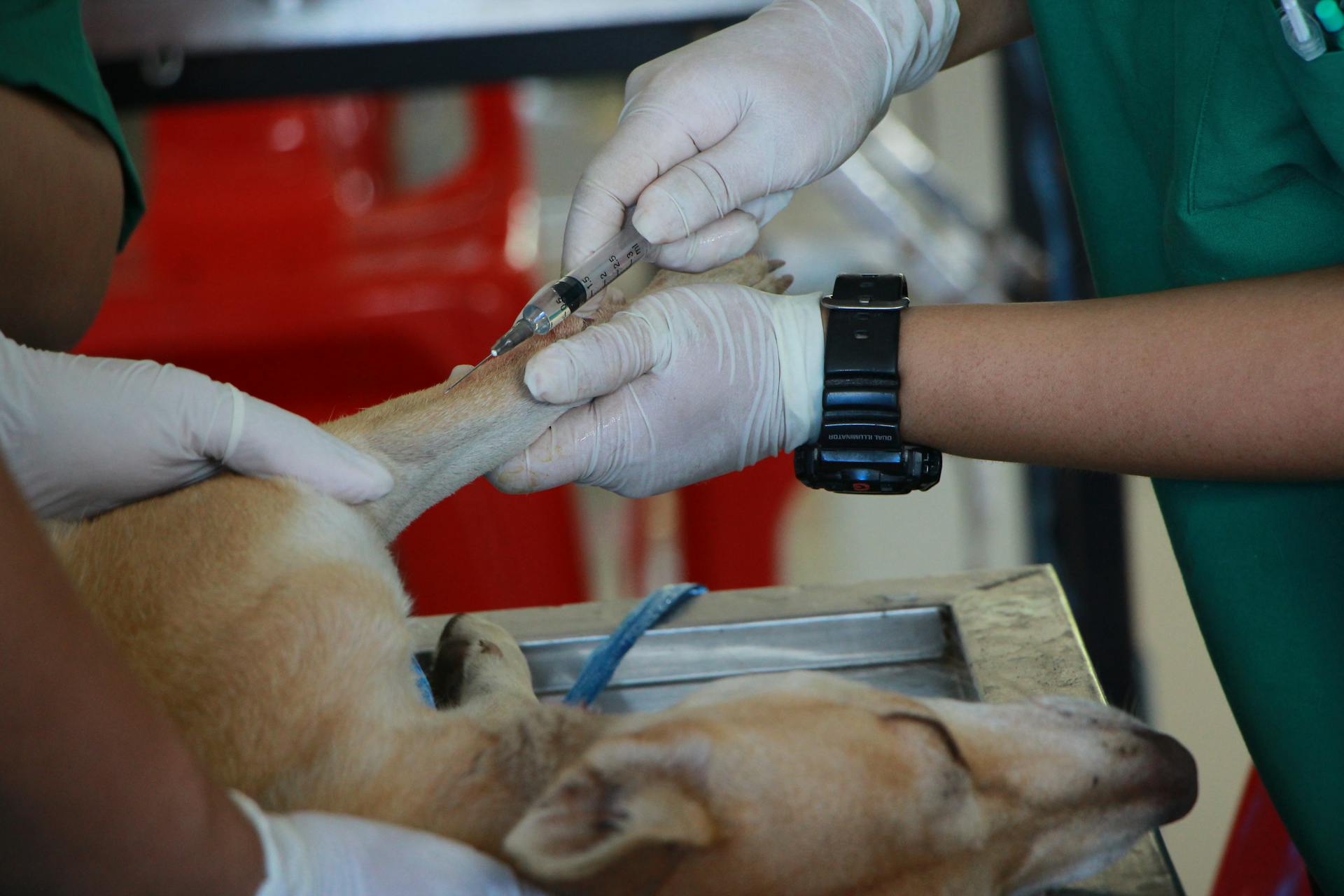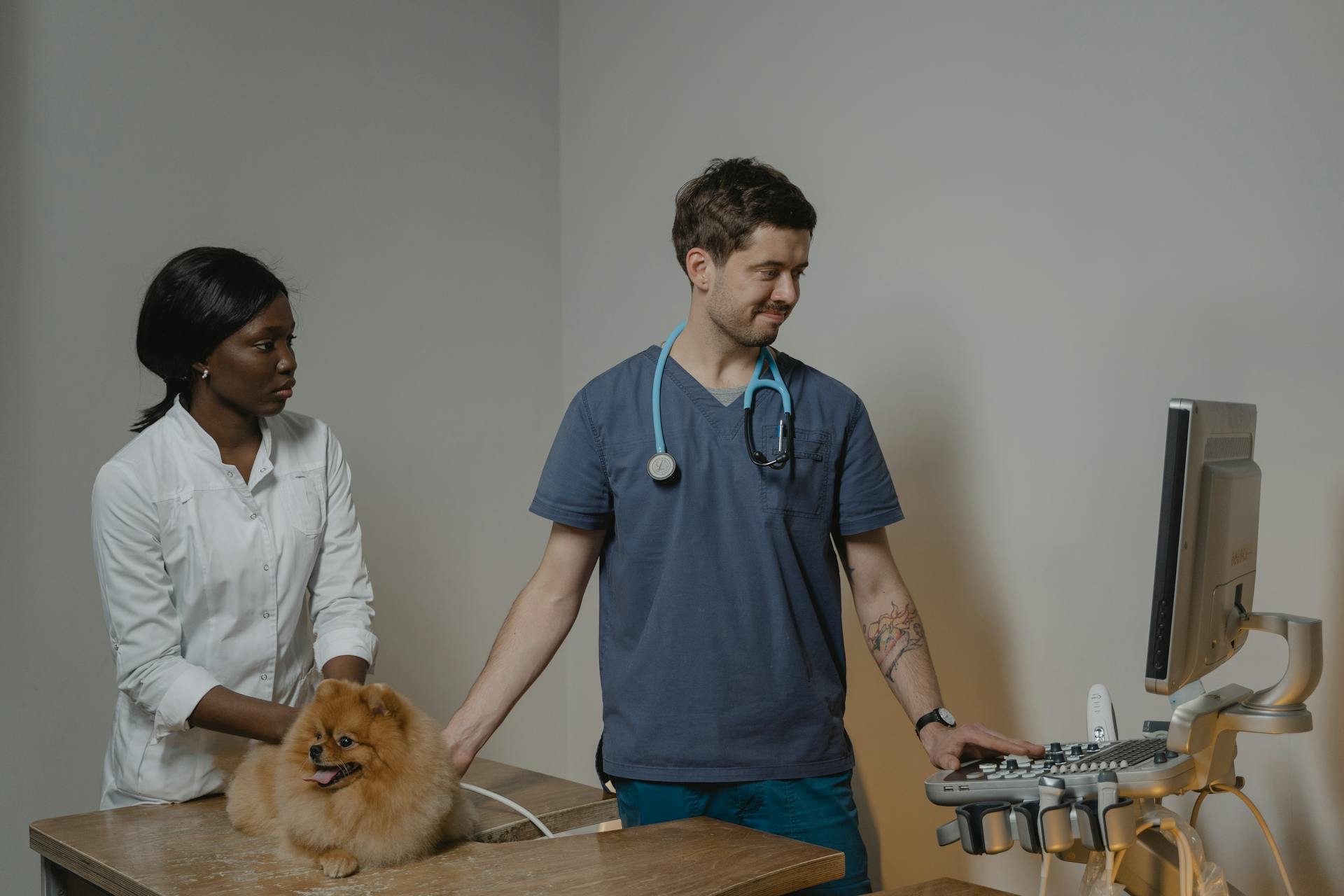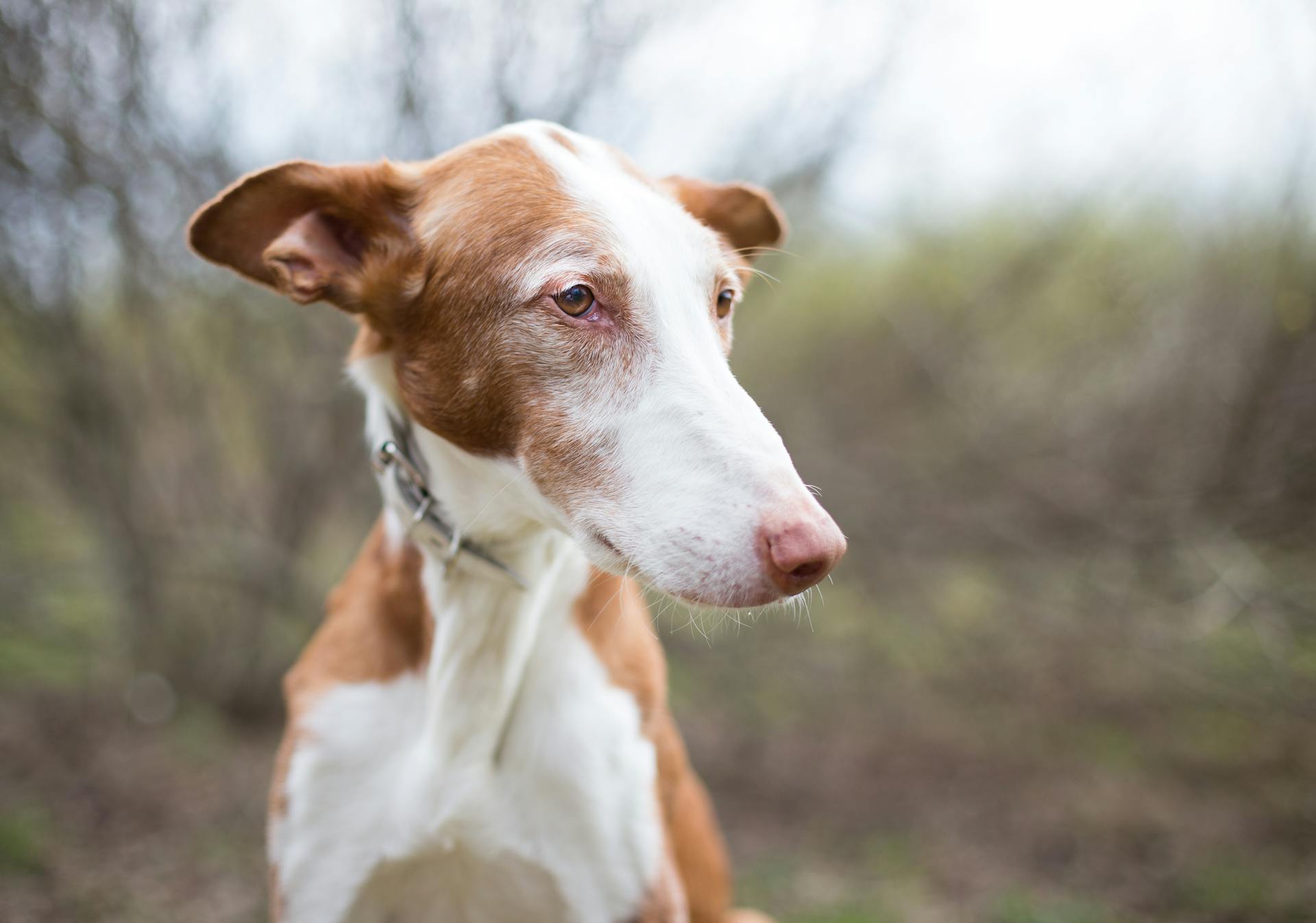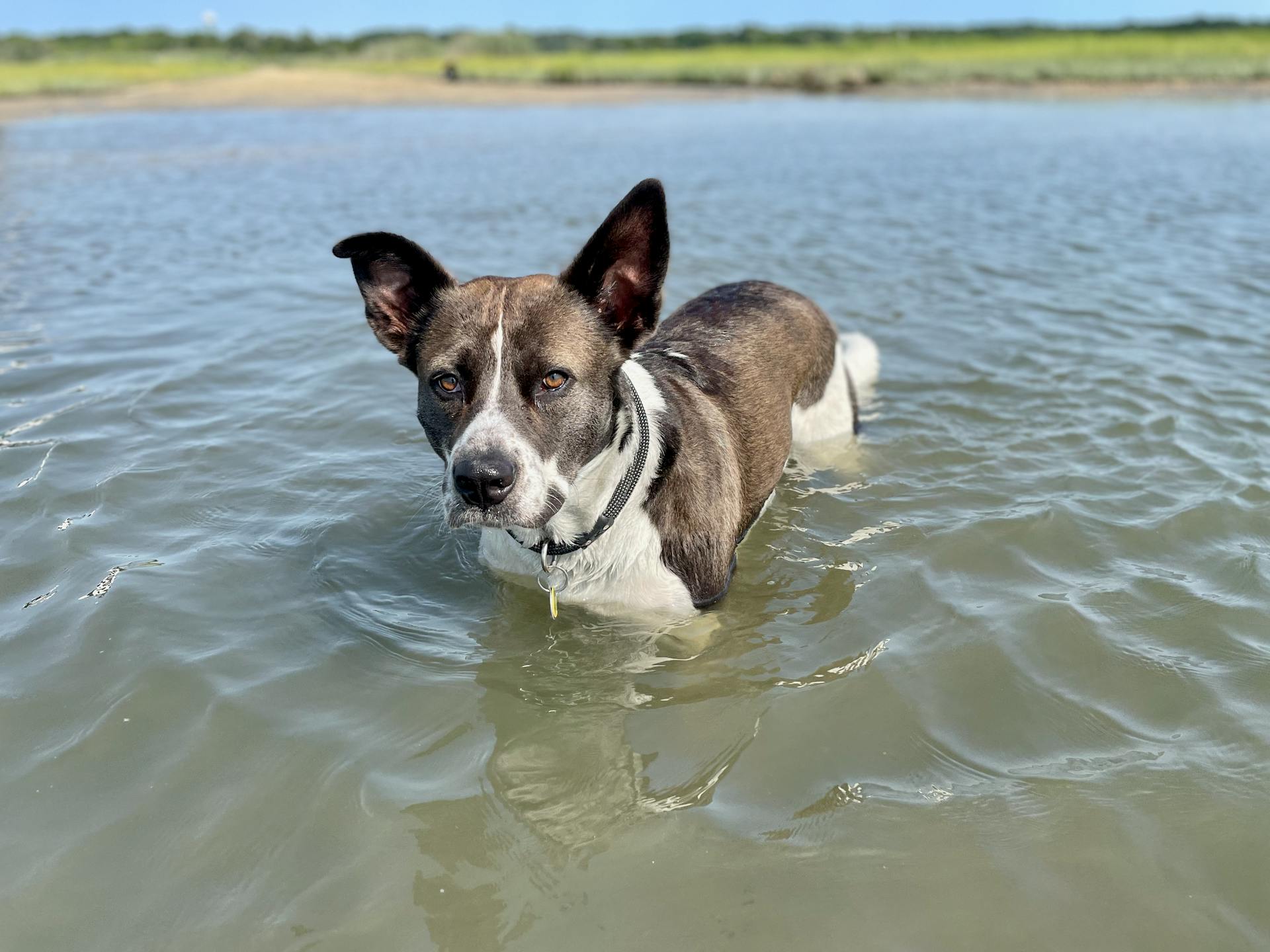
The Canine Parvovirus Vaccine is a crucial part of keeping your furry friend safe from this highly contagious and potentially deadly virus. The vaccine is usually administered in a series of 3-4 doses, with the first dose given at 6-8 weeks of age.
The Canine Parvovirus Vaccine is highly effective in preventing the disease, with a 95-99% success rate in preventing severe symptoms. However, it's essential to note that the vaccine does not guarantee complete immunity, and booster shots may be required to maintain protection.
The Canine Parvovirus Vaccine is typically given by a veterinarian, who will assess the dog's overall health and determine the best course of action. It's essential to follow the vaccination schedule and complete the series to ensure optimal protection.
What Is Parvo in Dogs?
Parvo in dogs is a serious and potentially life-threatening condition. Canine parvovirus is a highly infectious DNA virus that primarily targets the intestinal tract and bone marrow.
The virus affects the body's rapidly dividing cells, making young and unvaccinated dogs particularly susceptible. This is because their immune systems are still developing.
The intestinal tract is one of the most affected areas, leading to severe gastrointestinal symptoms. Heart muscle cells of very young puppies can also be damaged by parvovirus.
Causes and Prevention
The most important thing for preventing parvo is making sure you get your puppy in on time for their vaccines. Puppies should receive the canine parvo vaccine in a combination vaccine, such as DHPP or DAPP, every two to four weeks from 6–8 weeks to 16–20 weeks of age.
Areas where your puppy can come into contact with unvaccinated dogs, like dog parks, should be avoided. This is crucial for preventing parvo, as socializing with unvaccinated dogs can put your puppy at risk.
A dog will need to receive a booster vaccine at 1 year of age to be considered fully vaccinated.
Check this out: Canine Age
Symptoms and Diagnosis
If your dog is showing symptoms of parvovirus, it's essential to get them tested as soon as possible.
Fecal SNAP ELISA tests, also known as Parvo SNAP tests, are the most common way to diagnose parvo in dogs and puppies. This test requires a fecal swab and takes about 10 minutes.
A negative result from this test doesn't necessarily mean your dog is parvo-free, especially if they're symptomatic. In these cases, further testing may be needed.
Expand your knowledge: Canine Distemper Test
Parvo Stages in Dogs
Parvo stages in dogs can be a scary and unpredictable process, but understanding the different stages can help you identify the severity of the condition and provide the best possible care for your furry friend.
The incubation period for parvo is typically 3-10 days, during which time your dog may not show any symptoms at all.
As the virus starts to take hold, your dog will likely enter the prodromal stage, which is characterized by a decrease in appetite, lethargy, and a slight fever.
Discover more: Stages of Canine Distemper
During this stage, your dog's body is starting to weaken, making them more susceptible to secondary infections.
The most critical stage of parvo is the fulminant stage, which is marked by severe vomiting, diarrhea, and dehydration.
At this point, your dog's life is at risk, and immediate veterinary attention is crucial to prevent further complications.
The recovery stage is the final stage of parvo, but it can be a long and arduous process, requiring close monitoring and supportive care from your veterinarian.
Worth a look: How to Detox a Dog after Vaccines?
Diagnosing Canine Conditions: Tests and Diagnosis
Fecal SNAP ELISA tests, also known as Parvo SNAP tests, are the most common way of diagnosing parvo in dogs and puppies, requiring a fecal swab and taking about 10 minutes.
A negative result on this test doesn't necessarily rule out parvovirus in a symptomatic dog, as they may not be shedding the viral antigen at the time of testing.
Antibody tests are useful for monitoring immunity to CPV-2, and tests for determining antibody titers are performed on serum using enzyme-linked immunosorbent assays (ELISAs), indirect immunofluorescence antibody (IFA) tests, and hemagglutination inhibition (HI) tests.
A different take: Elanco Canine Parvovirus Monoclonal Antibody
The HI test is considered the gold standard for antibody tests, and several in-clinic ELISAs are commercially available, with at least one reported to correlate well with current gold standard tests.
A positive titer should be present 2 weeks after the final vaccination, and puppies with an HI titer ≤1:80 are considered susceptible to infection.
If the antibody test is negative or the titer is ≤1:80, the dog should be revaccinated, and the antibody test should be repeated 2 weeks later.
On a similar theme: Canine Distemper Adenovirus Type 2 Parainfluenza Parvovirus Vaccine
Vaccination and Treatment
The recommended route for CPV-2 vaccination is via subcutaneous or intramuscular administration, with intranasal administration inducing immunity but not recommended.
For puppies, vaccination should begin at 8 to 9 weeks and be repeated every 3 to 4 weeks until 14 to 16 weeks of age, as recommended by the AAHA and WSAVA guidelines.
Dogs in high-risk environments may benefit from an additional vaccination at 18 to 20 weeks of age, while those in shelter environments should receive vaccines at admission and every 2 to 3 weeks thereafter until 18 to 20 weeks of age.
To prevent parvo, it's crucial to get your puppy in on time for their vaccines, as the canine parvo vaccine is most often given in a combination vaccine.
Vaccination Schedule
The vaccination schedule for your furry friend is crucial to protect them from serious diseases. Core vaccines, like the DHPP vaccine, should be given to all dogs.
This combination vaccine protects against viruses that are highly contagious, cause serious disease, and have high fatality rates. It typically includes protection against canine distemper virus, two types of adenoviruses, parainfluenza, and parvovirus.
Puppies should start receiving vaccinations at 6-8 weeks of age and continue every 2-4 weeks until 16-20 weeks of age. This is crucial for preventing parvo, as getting the vaccine on time is essential.
The recommended route for parvovirus vaccination is via subcutaneous or intramuscular administration, and it should be given in combination with other core puppy vaccinations. For puppies younger than 16 weeks, vaccination should begin at 8-9 weeks and be repeated every 3-4 weeks until 14-16 weeks of age.
Dogs in a high-risk environment may benefit from an additional vaccination at 18-20 weeks of age. In a shelter environment, vaccines should be administered at admission and then every 2-3 weeks thereafter until 18-20 weeks of age.
Here's a summary of the vaccination schedule for puppies:
A booster vaccine should be administered 1 year after the initial series, and then not more often than every 3 years thereafter. Adult dogs that have never received a parvovirus vaccination should receive 2 doses at 3-4 weeks apart, although one dose with an MLV vaccine is likely protective.
Adverse Reactions
Severe adverse reactions to canine parvovirus vaccine can include anaphylaxis, dermatologic signs, and sudden death.
These reactions are more likely to occur after several doses of a vaccine series than after the first vaccine.
Animals with a history of type I reactions or displaying clinical signs should be monitored for 15 to 30 minutes after vaccination.
Inflammatory immune responses can result in delayed adverse reactions such as pain, pruritus, and lethargy, which typically manifest 2 to 3 days after vaccination.
These signs usually resolve within 12 to 24 hours.
Small-breed dogs are more susceptible to adverse reactions than large dogs.
Dogs weighing less than 10 kg are about 4 times more likely to experience an adverse vaccine reaction.
Breed-specific risks include dachshunds, pugs, Boston terriers, miniature pinschers, and Chihuahuas, which are at highest risk for development of an adverse reaction.
Receiving more than 4 vaccines during a visit significantly increases the risk of an adverse reaction, with dogs being nearly 2 times more likely to experience a reaction.
Sources
- https://vet.tufts.edu/news-events/news/canine-parvovirus
- https://todaysveterinarypractice.com/preventive-medicine/canine-parvovirus-vaccination/
- https://www.petmd.com/dog/general-health/dhpp-vaccination-for-dogs
- https://www.petmd.com/dog/conditions/infectious-parasitic/parvo-in-dogs
- https://urgentvet.com/what-dog-owners-should-know-about-parvovirus/
Featured Images: pexels.com


